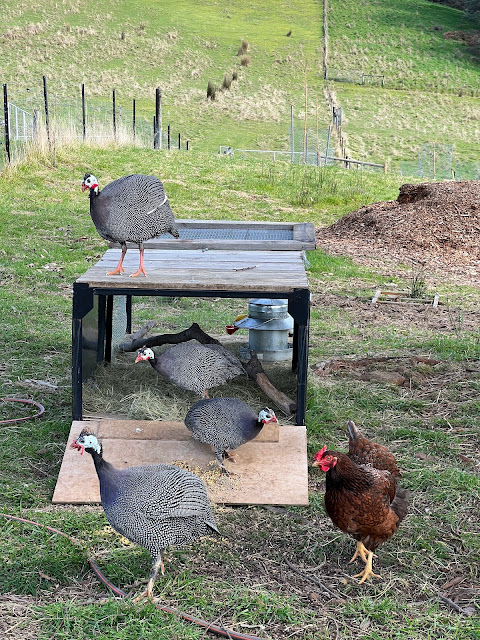The poultry poser …
Last October, we bought a dozen fertile Wyandotte chicken eggs and incubated them. Of these, 8 hatched giving us an even split of 4 hens and 4 roosters. They roam the top paddock freely during the day and either follow the food to bed or alternatively round themselves up promptly as dark falls and head off to roost. Although a little slow off the mark, the hens have been laying very well and we are regularly getting 2 to 4 eggs day. Any eggs we are unable to use we give to our neighbours and thus claim for ourselves the title of primary producers! There's a profound satisfaction in consuming these free-range eggs with their vibrant yellow yolks laid by happy hens. Apart from the minor hiccup of losing one of the roosters to what appeared to be a problem with his crop, the little flock appeared to be thriving. Unbeknown to us, however, there was trouble brewing in paradise...
About a week ago we opened the coop in the morning and found blood everywhere. Two of the roosters (numbers 2 and 3 in the pecking order) had been fighting each other overnight. Their combs were badly pecked and bloody and they looked more than a little punch drunk. The battle continued during the day with loud crowing followed by rounds of violence. On numerous occasions we tried to separate them, but their focus and desire to do damage was absolute. We were just starting to face the reality of having to dispatch the troublesome twosome when we spied a poster on the wall of the local supermarket announcing a “poultry amnesty”.
It turns out that a favourite rooster disposal method in the local area is simply to drop them off on the side of the road somewhere! This of course has the undesired side effect of creating gangs of feral roosters prowling around. The amnesty seeks to avoiding the random rooster drop-off or indeed the unnecessary culling of unwanted poultry. The birds are simply handed in on a designated amnesty day and the organisers do their best to re-house them. After an inelegant half hour or so spent catching the two scoundrels, we set off to hand them in, and were completely taken by surprise at the sheer number of roosters involved. The chances of finding them all new homes could be best characterised as slim or none, but a slender second chance is better than none at all.
Just as we were about to leave, we met a couple who were dropping off a male guinea fowl. This seemed like a great opportunity to pick up a friend for our lonely female, so we grabbed a box and offered him a new home. To boost our guinea fowl numbers further we took a drive into the mountains around Glen Huon to meet a poultry whisperer and bought another two females. We also received in addition, and free of charge, several extremely useful tips on the keeping of poultry! After keeping the new birds confined for 3 days, we took a deep breath and let them out. After a minor altercation with some of the chickens, they seem to have settled down … or at least they haven’t flown away yet.
The mob mentality is strong in guinea fowl and our 4 birds stick quite closely together. They are, however, particularly noisy and incredibly stupid birds. They fly quite well, but when one happens to become separated from the rest of the gang by a fence, rather than simply flying over and rejoining the group, it will run up and down the fence squawking inconsolably. The collective noun for guinea fowl is a "confusion" of guinea fowl which seems to be particularly apt. If, however, they control the ticks in the top paddock and help warn us of snakes then all idiosyncrasies will be forgiven.
Wyandotte hens are known to be broody so now we are hoping for one of ours to sit on a few eggs to regenerate the flock. We also hope that one of the hens may be persuaded to take on some guinea fowl eggs because apparently guinea fowl are terrible parents! In any event, it’s all happening on the poultry front. The story would have a very happy ending (at least thus far), if we knew that our two quarrelsome roosters had found new homes somewhere, but then again perhaps on this score ignorance is bliss.








Comments
Post a Comment